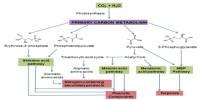Endogenous retroviruses (ERVs) are remnants of ancient retroviral infections that have become a permanent part of the genome of a host organism. ERVs are endogenous viral elements in the genome that are similar to and can be derived from retroviruses. Retroviruses are RNA viruses that can incorporate their genetic material into the DNA of the host cell. They are abundant in the genomes of jawed vertebrates and make up to 5-8% of the human genome (lower estimates of 1%).
When a retrovirus infects a germ cell (sperm/egg cell), the integrated viral DNA becomes a heritable part of the host organism’s genome and is passed on to future generations. These integrated retroviral sequences can accumulate in organism genomes over evolutionary time.
Key features of endogenous retroviruses include:
- Integration into the host genome: When the genetic material of a retrovirus is integrated into the DNA of a germ cell, ERVs are formed. During reproduction, this integrated viral DNA is passed on to offspring.
- Structural components: ERVs typically have three main genes, which are similar to those found in retroviruses: gag, pol, and env. Many ERVs, however, have accumulated mutations over time, rendering them inoperable. Although some ERVs retain the ability to generate viral particles, they are usually not infectious.
- Abundance: ERVs account for a sizable portion of the genomes of many organisms, including humans. In some cases, they can account for a sizable portion of the genome.
- Evolutionary significance: While ERVs are often considered “junk DNA” or “genomic fossils,” they can have functional implications. Some ERVs have been co-opted by the host organism for various functions, such as influencing gene regulation or contributing to the evolution of new genes.
- Role in diseases: ERV misregulation or activation has been linked to a variety of diseases, including autoimmune disorders and cancer. ERV expression can be influenced by a variety of factors, and their activity may have an impact on the host’s health.
ERVs are a vertically inherited proviral sequence and a subclass of a type of gene known as a transposon, which can normally be packaged and moved within the genome to play an important role in gene expression and regulation. ERVs, on the other hand, lack most transposon functions, are typically not infectious, and are frequently defective genomic remnants of the retroviral replication cycle. Because of their integration and reverse transcription into the host cell’s nuclear genome, they are classified as germline provirus retroelements.
















